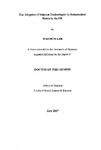The Adoption of Internet Technologies by Independent Hotels in the UK
| dc.contributor.author | LIM, WAI MUN | |
| dc.contributor.other | Plymouth Business School | en_US |
| dc.date.accessioned | 2013-11-22T16:04:00Z | |
| dc.date.available | 2013-11-22T16:04:00Z | |
| dc.date.issued | 2007 | |
| dc.identifier | NOT AVAILABLE | en_US |
| dc.identifier.uri | http://hdl.handle.net/10026.1/2825 | |
| dc.description | Merged with duplicate record 10026.1/670 on 27.02.2017 by CS (TIS) | |
| dc.description.abstract |
The growth of the technology and its range of possible uses have made it a necessity for independent hoteliers to examine their use of the internet, specifically its effectiveness for marketing and distribution purposes. It is widely recognised that the independent hotel sector makes up the bulk of the hotel industry in the UK and often do not have the resources or desire to keep up with new technologies. This study scrutinizes, evaluates and establishes the factors that influence the decision to adopt a range of internet technologies for marketing and distribution within the UK Independent hotel sector. The conceptual framework of this study is underpinned by Davis's Technology Acceptance Model (1989) and Rogers' Diffusion of Innovations model (1995). The study's findings have confirmed, challenged and extended these two theories. Critically, it has established that the ease-of-use of a technology and its affordability do not affect hoteliers' deployment decisions, when numerous studies have suggested otherwise. The study also revealed that the hotel sector as a whole had not only expanded the range of internet technologies adopted, but the proportion of adopters had also increased. A series of qualitative exploratory interviews were carried out and analysed to inform a larger quantitative survey. Survey data was collected from 408 independent hoteliers and analysed to contribute to the conceptual development of a taxonomy. In the process, hypotheses testing, regression, discriminant and cluster analysis were carried out, linking various hotel characteristics, hotelier perceptions and their propensity to deploy internet technology for marketing and distribution. The core of the developed taxonomy illustrated three groups of hoteliers: the internet application (IA) reticent; the IA realist; and the IA rationalist. This taxonomy, supported by a more precise profile and definition of independent hoteliers, facilitated the identification of managerial implications for various stakeholders. A significant implication of the study inferred that travel intermediaries' will continue to have a sustained stronghold on independent hoteliers. | en_US |
| dc.language.iso | en | en_US |
| dc.publisher | University of Plymouth | en_US |
| dc.title | The Adoption of Internet Technologies by Independent Hotels in the UK | en_US |
| dc.type | Thesis | |
| plymouth.version | Full version | en_US |
| dc.identifier.doi | http://dx.doi.org/10.24382/4766 | |
| dc.identifier.doi | http://dx.doi.org/10.24382/4766 |
Files in this item
This item appears in the following Collection(s)
-
01 Research Theses Main Collection
Research Theses Main


